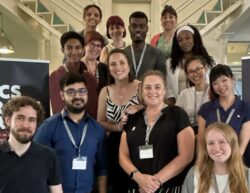Rare Disease 101 fills the gap in medical education
Written by Dr Thomas Dunne, Trust Grade SHO in Paediatrics & M4RD Clinical Ambassador
When reflecting on your experiences of undergraduate medical education on rare diseases, what comes to mind? A final lecture slide offering little-known eponymous conditions? The impossible notion of covering hundreds of specific diseases individually? The relevance of understanding diseases that you may never encounter? Such opinions mirror those of many. With the curriculum emphasising that ‘common things are common’, and that ‘when you hear hooves, think horse’. And to the most part, I agree with this approach; it is vital for a doctor to start their career with a good understanding of general medicine, knowing how to investigate and manage common ailments. However, on the occasion that hooves in fact mean Zebra, a clinician needs to feel comfortable in knowing what to do.
Rare disease in medical education
Don’t get me wrong, I am not advocating that every clinician be able to reel off the ~70001,2 conditions that fall under the rare disease umbrella. In fact, my feelings are quite the opposite. The medical profession is populated with generalists and specialists for the very reason that not all doctors should be required to attain the skills and knowledge to diagnose and manage the full spectrum of conditions attributable are subjected to. What I am advocating for is reason that every clinician understands the approach to manage and support patients with undiagnosed and rare conditions. For many of these patients, the diagnostic odyssey is long, taking years to reach a correct diagnosis. These years often cluttered with difficult consultations and invasive investigations. When recounting their experiences, patients and their loved ones often echo the same key messages: in learning the rarity of their diagnosis, they would not have expected a clinician have given them an answer at their first consultation. What is important is for a clinician to listen to concerns, question diagnoses, be honest and open, ask for help and be willing to learn alongside the patient. For me, this is where rare diseases 101 can play an important role in medical education.
What is important is for a clinician to listen to concerns, question diagnoses, be honest and open, ask for help and be willing to learn alongside the patient.
Rare Disease 101
‘Rare Disease 101 –The Basics of Rare Disease’ is a novel educational tool and the first of its kind. The aims of the course are simple: to introduce the concept of rare disease, to educate healthcare professionals on the impact of living with a diagnosis and to provide clinicians with practical knowledge and tools to be able to manage conditions that fall into this bracket. Rare Disease 101 does this by approaching rare disease as a unified concept, as opposed to looking at each in-turn. Through this approach it teaches the student of the similarities in the medical journeys of patients with rare diseases, and highlights the challenges faced by both patients and clinicians in the field. These important messages are augmented with cases and patient stories.
Tools and pragmatic tips
The later modules introduce some useful diagnostic tools, along with tips on supporting patients through advocacy groups. With over 70% of rare diseases stemming from a genetic cause, the module on genomic medicine highlights the important role genomics plays diagnosing rare diseases through the NHS Genomic Medicine Service.3.
Overall, Rare Disease 101 successfully provides the clinician with the skills to approach a clinical encounter with a patient with an undiagnosed rare condition. For clinicians, the modular layout allows the course to easily be incorporated into a busy work schedule, and through utilising an online platform allows it to be accessed anywhere. Its interactive, clear and varied content create an engaging module suitable to all those working in healthcare.

Why is Rare Disease 101 relevant to every clinician? Every clinician has a duty of care to their patient, and it sometimes takes a second set of eyes to say “this doesn’t quite fit”; to take that extra step, make that extra referral, write to a specialist for advice.
Whether medical student or consultant, it could be you that makes the difference.
The 101 series aims to equip doctors with the knowledge and skills to manage, support and advocate for patients with rare diseases.
Common things are common, and with 1 in 174 of us developing a rare disease, it won’t be long until a rare patient enters your clinic.

You can access Rare Disease 101 here or via the LEARN section of the M4RD navigation bar.
References
- Haendel M, Vasilevsky N, Unni D, Bologa C, Harris N, Rehm H, Hamosh A, Baynam G, Groza T, McMurry J, Dawkins H, Rath A, Thaxon C, Bocci G, Joachimiak MP, Köhler S, Robinson PN, Mungall C, Oprea TI. How many rare diseases are there? Nat Rev Drug Discov. 2020 Feb;19(2):77-78. doi: 10.1038/d41573-019-00180-y. PMID: 32020066; PMCID: PMC7771654.
- Rare Diseases. Findacure. Available at: https://www.findacure.org.uk/rare-diseases/.
- What is a rare disease? Eurordis, July 2020. Available at https://www.eurordis.org/content/what-rare-disease
- Department of Health. The UK Strategy for Rare Diseases. 2013




